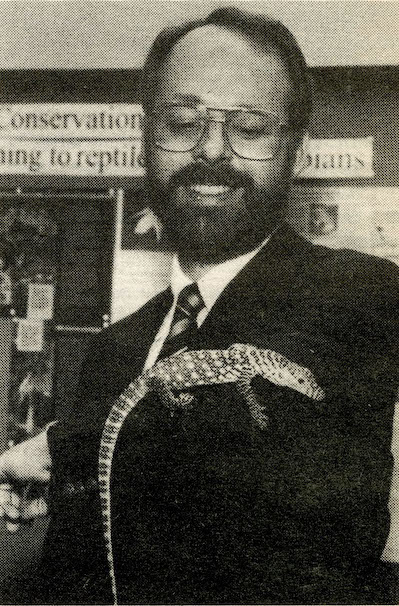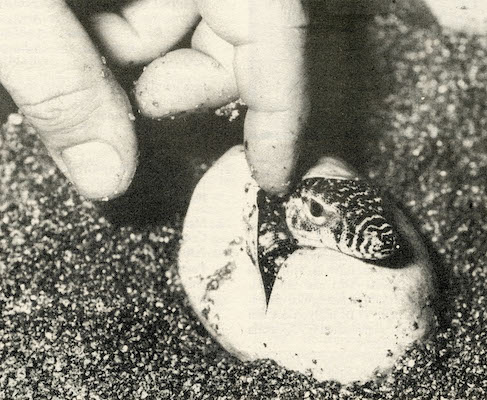This story ran in the October 30, 1992, print edition of the Mason Gazette.

In the movie “The Freshman,” Matthew Broderick agrees to deliver a Komodo dragon, a rare and endangered lizard, to Marlon Brando—illegally. George Mason University biology professor Geoffrey Birchard has also had Komodo dragons delivered to him—but legally, as part of a joint project with the National Zoological Park in Washington, D.C.
Birchard, a herpetologist, was called on by the zoo's curator of herpetology, Dale Marcellini, last January to incubate 10 of the 26 eggs that were the result of a monthlong courtship between the zoo's two 10-year-old lizards. The adult lizards had been given to the zoo in 1988 by the ambassador of lndonesia.
During the eight-month incubation period, several eggs died, but on Sept. 13, in one of the university's labs, the first dragon hatched out of his leathery-shelled egg. Twelve others quickly followed their brother's lead. Two more are still to go.
''Everyone here is beaming with pride," says Marcellini.
Marcellini turned to George Mason University because he literally did not want to put all his eggs in one basket and wished to avoid potential disasters, like electricity failure or fire, that could destroy the eggs. And George Mason had higher-quality incubators.
The university's eggs hatched first because they were kept at a slightly higher temperature. which accelerated the process.
“Things went extremely well," says Birchard. ''We're looking forward to doing other projects [with the zoo] as well."
This is not the first time Birchard has been involved with the National Zoological Park. Over the past five years, he has served as a consultant for the zoo. And in return the zoo has donated surplus eggs—including those of pythons and milk snakes—to Birchard for his research on the physiology of developing animals.

During the dragons' incubation period, he performed metabolic studies on the embryos, recording the gas exchange between the eggs and the environment.
“This proved to be quite an experience," says Birchard. “Every day for the past eight months l had to come in to make sure the eggs were okay. But professionally, this was a once-in-a-lifetime opportunity.”
When born Komodo dragons, whose natural habitat is the Komodo and Flores islands, off the coast of Indonesia, are about 8 to 16 inches long and weigh up to 4 ounces. Their yellow, brown, and black skin is heavily patterned with chevron and circle markings—and yes, they have a forked tongue. Gradually their striking skin turns a uniform gray and eventually they can weigh as much as 300 pounds and reach a length of more than 10 feet, making them the world's largest lizards. The National Zoological Park is the first only other place in North America where place to breed the lizard outside of Indonesia.
At present, all the young Komodo dragons are back at the zoo, happily feeding on mice and insects. A few are already on display at the Reptile House.
"These guys are Iike scaly pandas when it comes to getting people excited," says Marcellini.
Plans are being discussed to send some of the babies to other zoos and to loan the female adult dragon to the Cincinnati Zoo, the only other place in North America where Komodo dragons are kept.
The Mason Gazette, University and Student Publications, #R0128, Special Collections Research Center, George Mason University Libraries.
More Dragon Stories
- August 11, 2022
